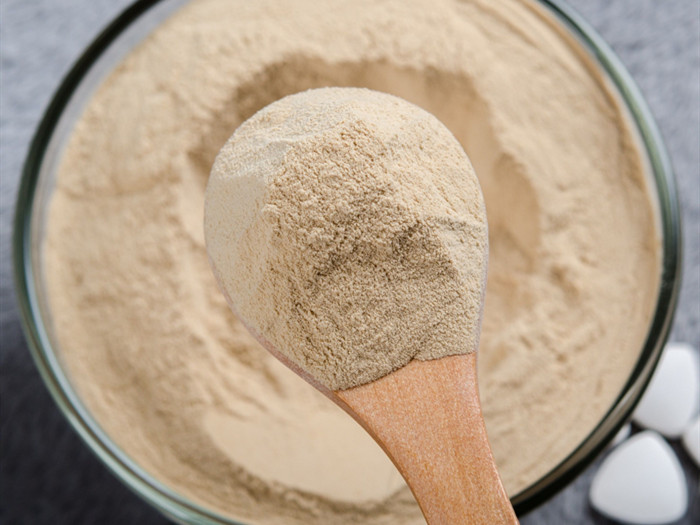In recent years, the abuse of antibiotics in the animal breeding industry has aroused great concern about food safety and environmental harm, and now it is time to find a safe and effective substitute. Yeast cell wall(YCW in short, is also referred as Yeast MOS), is a natural green immune enhancer and is considered as one of the main products to replace antibiotics, has been widely used in animal health products and demildew agent products as a main raw material. The yeast cell wall is mainly composed of mannan, β -glucan and binding proteins. Mannan can adsorb pathogenic bacteria and mycotoxins. β -glucan can enhance the immunity of ruminants and is mainly used as the main raw material in immune enhancer products. A large number of applied studies and feedbacks showed that yeast cell wall, as a feed material added to the ruminant diet, could enhance immunity, absorb mycotoxins, and improve performance (daily gain, milk yield) and product quality (milk and meat quality) of ruminants.
What’s Yeast Cell Wall?
The yeast cell wall is a green nutritional product obtained from saccharomyces cerevisiae treated by specific acid and enzymatic hydrolysis. The main components of the yeast cell wall are β -glucan, mannan oligosaccharide, glycoprotein and chitin. β -glucan is composed mainly of D-glucose bound by the β-1,3/1,6 bond. This special structure can activate macrophages, natural killer cells, T cells and B cells, improving the animal’s resistance to disease. Mannan oligosaccharide is another important polysaccharide component of the yeast cell wall and has many biological activities. Mannan oligosaccharides are similar to the receptors of many pathogenic bacteria on the intestinal wall of animals and can bind with pathogenic bacteria, seize the binding site, adsorb and exclude intestinal pathogenic bacteria. At the same time, it is also good prebiotics, effectively promote the proliferation of beneficial bacteria, regulate the microbial balance of animals.
Compared with livestock, poultry and aquatic animals, the mechanism of action on yeast cell walls is more complex and applied to ruminants. Yeast cell wall, as a functional polysaccharide, partly binds to mycotoxins in feed through a double helix structure in the rumen, adsorbs mycotoxins, and prevents mycotoxins (aflatoxin B1, etc.) from exceeding the standard in milk. The other part is degraded into digestible sugars by rumen microorganisms, which participate in rumen microbial protein synthesis and promote milk protein synthesis and improve milk protein levels. There are also some undegraded yeast cell walls with feed nutrients, after entering the intestinal tract to play its immune, adsorption of pathogenic microorganisms, thereby reducing the occurrence of disease.
Compared with livestock, poultry and aquatic animals, the mechanism of action on the yeast cell wall extract is more complex and applied to ruminants. Yeast cell wall, as a functional polysaccharide, partly binds to mycotoxins in feed through a double helix structure in the rumen, adsorbs mycotoxins, and prevents mycotoxins (aflatoxin B1, etc.) from exceeding the standard in milk. The other part is degraded into digestible sugars by rumen microorganisms, which participate in rumen microbial protein synthesis and promote milk protein synthesis; There are also some undegraded yeast cell walls with feed nutrients, after entering the intestinal tract to play its immune, adsorption of pathogenic microorganisms, thereby reducing the occurrence of disease.
- Regulate gastrointestinal health
The yeast cell wall belongs to the outer structure of yeast cells, which is composed of mannan oligosaccharides and β -glucan. It is mainly made from fermented breast milk through hydrolysis, separation and drying. The effective components obtained by different hydrolysis, separation and drying processes are different, and the efficacy is also different. Heinrichs (2003) reported that adding yeast cell wall can optimize the gastrointestinal microecological environment of calves, promote the proliferation of beneficial bacteria such as intestinal bifidobacteria and inhibit the proliferation of pathogenic bacteria such as Escherichia coli. It was found that adding 75mg/kg yeast β -glucan to milk replacer could alleviate the growth performance degradation and small intestinal morphology damage caused by e. coli challenge, thus ensuring healthy growth of calves, and could replace or reduce the use of antibiotics to a certain extent. Dietary supplementation with 75mg/kg yeast β -glucan significantly increased rumination times, rumination time and daily gain of early-weaned lambs at 28 days of age.
- Boost immunity
β -glucan contained in the yeast cell wall can stimulate nonspecific and specific immune responses and enhance disease resistance. Mannan oligosaccharides in yeast cell walls. It can absorb pathogenic microorganisms and some mycotoxins to ensure the health of the body. It has been reported in the past that adding yeast cell wall to the diet of cattle and sheep can enhance disease resistance and prevent diarrhea of calves and lambs. In an applied study on calves, the number of E. coli in the faeces of dairy cows fed with 2 g yeast cell wall per day for 5 weeks was significantly reduced and respiratory disease was reduced from 9.9% to 3%. It was found that adding yeast β -glucan to the diet of weaned calves significantly increased the contents of IgG and IgM in serum, reduced the diarrhea of calves, and increased the resistance to endotoxin and improved the body immunity.
- Improve meat and milk quality
Studies have shown that supplementation of 0.5%-1% yeast cell wall in dairy diet can significantly improve the growth efficiency of rumen microorganisms by stabilizing rumen health, meaning that the same unit of digestible organic matter can produce more MCP for milk protein and meat protein synthesis. At the same time, the increase of VFA production also contributed to the increase of milk fat percentage and intramuscular fat content in meat. The practical application results of pasture showed that milk protein could be increased by 0.1-0.2 percentage points (for example, milk protein could be increased from 3.1% to 3.2-3.3%), milk fat percentage could be increased by 0.1-0.3 percentage points, and milk yield could also be increased to a certain extent.
The YCW is a kind of organic mycotoxin adsorbent, which is widely used in the inorganic + organic compound demildew products, mainly absorbing zearalenone, emitoxin and aflatoxin. Yeast glucan has a helical molecular structure, and its special configuration can form a specific complementary structure with a variety of mycotoxins, so as to firmly bind with a variety of mycotoxins, and expel animals through the intestinal tract. In addition, yeast glucan can specifically degrade mycotoxins in feed by activating phenoloxidase system and oxidizing prophenoloxidase to phenoloxidase, so as to play the role of adsorption and detoxification and reduce the risk of aflatoxin in milk exceeding the standard.
Mannan in yeast cell wall adsorbs pathogenic microorganisms in dairy cows, while β -glucan can increase the content of white blood cells, cytokines and immunoglobulin in blood of dairy cows, stabilize and enhance humoral immunity and cellular immunity, reduce the occurrence of mastitis, and reduce milk somatic cell count.
Rainbow is committed to the nutritional safety and health of ruminants. Our high-quality yeast cell wall extracts are prepared using special fermented breast milk, which is hydrolyzed, separated and spray dried with specific enzymes. It is rich in mannan and β -glucan, which can enhance rumen healthy and stable function, immune and toxin absorption function of Mannan animal, increase milk protein and milk fat and reduce mycotoxin residue.
- Dandelion Extract: What It Is, Benefits, Uses and Side Effect - April 23, 2024
- Is Berberine Extract Help For Weight Loss? - April 11, 2024
- Why Is Pysllium Husk Powder A Popular Meal Replacement Ingredient? - April 3, 2024



